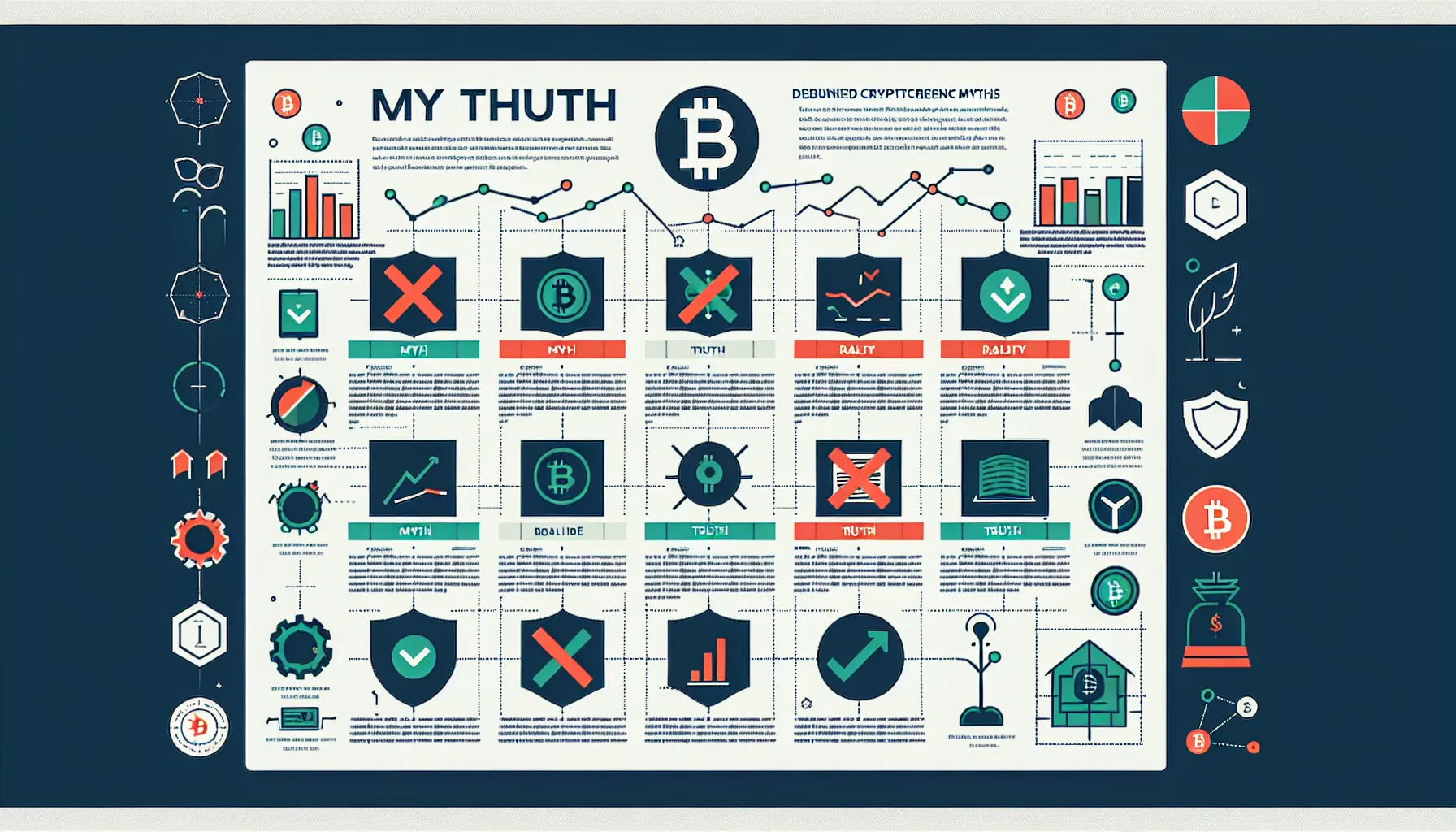Cryptocurrency continues to captivate new investors worldwide, yet the space remains shrouded in misunderstanding. From exaggerated fears about security to outdated notions about accessibility, many myths persist that can mislead those considering their first crypto purchase. These misconceptions often stem from early headlines, incomplete information, or sensationalised media coverage that fails to reflect how the industry has matured.
Understanding the truth behind these myths is crucial for anyone entering the crypto market. Whether it’s the belief that Bitcoin is exclusively a tool for criminals or the assumption that investing requires thousands of pounds upfront, these falsehoods can prevent well-informed choice-making and lead to costly mistakes. This article debunks 15 of the most common crypto myths new investors still believe, replacing fiction with fact and providing a realistic perspective on what cryptocurrency investing truly involves.
Key Takeaways
- New investors can start crypto investing with as little as £10, as cryptocurrencies like Bitcoin are divisible into millions of smaller units.
- Only about 2% of Bitcoin transactions involve criminal activity, far less than the proportion found in traditional finance.
- Cryptocurrencies vary enormously in purpose and technology—Bitcoin serves as digital gold whilst Ethereum enables smart contracts and decentralised applications.
- Crypto investing carries significant risk and volatility, requiring realistic expectations rather than treating it as a get-rich-quick scheme.
- Losing your private keys means permanent loss of funds, as no customer service can recover them in decentralised systems.
- Cryptocurrency is increasingly regulated, with bodies like the UK’s FCA requiring exchanges to comply with anti-money laundering and KYC requirements.
1. You Need Thousands to Start Investing in Crypto

One of the most pervasive myths is that crypto investing is only for the wealthy. New investors often assume they need substantial capital to purchase Bitcoin or other cryptocurrencies, but this couldn’t be further from the truth.
The Reality: Cryptocurrencies are highly divisible. Bitcoin, for example, can be broken down into 100 million smaller units called satoshis. This means investors can start with as little as a few pounds and still own a meaningful fraction of Bitcoin. Most exchanges and investment platforms have minimal deposit requirements, often as low as £10 or even less, making crypto accessible to virtually anyone with an internet connection.
This divisibility democratises access to the asset class. Whether someone has £20 or £20,000 to invest, they can participate in the crypto market proportionally. The barrier to entry is significantly lower than many traditional investment vehicles, which may require minimum account balances or larger initial purchases.
2. Bitcoin Is Only Used for Illegal Activities
Perhaps no myth has been more damaging to cryptocurrency’s reputation than the belief that Bitcoin primarily facilitates criminal activity. This misconception stems from early high-profile cases involving darknet markets and ransomware attacks.
The Facts: Research from blockchain analytics firms consistently shows that illicit activity represents a tiny fraction of total Bitcoin transaction volume. Chainalysis estimates that only about 2% of Bitcoin transactions relate to criminal activity, far less than the proportion in traditional finance, where the United Nations estimates that 2-5% of global GDP involves money laundering.
Bitcoin’s public ledger actually makes it a poor choice for criminals. Every transaction is permanently recorded on the blockchain, allowing law enforcement agencies to trace illicit funds with sophisticated analytics tools. In fact, several high-profile criminal cases have been solved precisely because investigators could follow the digital trail left on the blockchain. The vast majority of Bitcoin usage today involves legitimate investment, remittances, payment processing, and wealth preservation.
3. Cryptocurrency Has No Real-World Value
Sceptics often dismiss cryptocurrency as worthless digital tokens with no intrinsic value or practical application. This view overlooks the genuine utility that many crypto assets provide.
The Truth: While some tokens are purely speculative, established cryptocurrencies power innovative solutions to real-world problems. Bitcoin serves as a decentralised store of value and medium of exchange, particularly valuable in countries with unstable currencies or restrictive banking systems. Ethereum enables smart contracts, self-executing agreements that eliminate intermediaries in transactions ranging from insurance claims to property transfers.
Crypto facilitates fast, low-cost international remittances, an essential service for millions of migrant workers sending money home. Blockchain technology underpins supply chain tracking, digital identity verification, and decentralised finance (DeFi) platforms that provide banking services to the unbanked. The value proposition extends beyond speculation: it’s about creating more efficient, transparent, and accessible financial infrastructure.
4. All Cryptocurrencies Are the Same
New investors sometimes view the crypto market as a homogeneous collection of interchangeable digital coins. This oversimplification can lead to poor investment decisions and missed opportunities to understand what makes each project unique.
The Reality: Cryptocurrencies vary enormously in their purpose, technology, governance structures, and value propositions. Bitcoin was designed as digital gold, a decentralised, deflationary store of value with a fixed supply of 21 million coins. Ethereum, by contrast, functions as a programmable platform for decentralised applications and smart contracts, with different consensus mechanisms and monetary policy.
Beyond these two, thousands of other crypto assets serve distinct niches. Stablecoins like USDC maintain pegs to fiat currencies for reduced volatility. Privacy coins like Monero focus on transaction anonymity. Utility tokens provide access to specific blockchain services. Understanding these differences is essential for investors seeking to build diversified portfolios aligned with their risk tolerance and investment thesis. Treating all cryptocurrencies as identical ignores the fundamental distinctions that drive their individual success or failure.
5. Crypto Is a Get-Rich-Quick Scheme
Stories of overnight millionaires created by early Bitcoin investments have fostered unrealistic expectations. Many newcomers enter the market expecting guaranteed returns and rapid wealth accumulation.
The Facts: Cryptocurrency is a volatile, high-risk investment class. For every investor who achieved substantial gains, countless others have lost money through poor timing, scams, or misunderstanding market dynamics. Price swings of 10-20% in a single day aren’t unusual, and many cryptocurrencies have lost 80-90% of their value during market downturns.
Responsible investing requires research, risk management, and realistic expectations. Investors should only commit funds they can afford to lose, diversify across assets, and maintain a long-term perspective rather than chasing short-term gains. The crypto market rewards patience and education, not speculation and greed. Those who approach it as a get-rich-quick scheme often become victims of their own unrealistic expectations or, worse, fall prey to fraudulent projects promising guaranteed returns. Like any investment, success in crypto requires diligence, discipline, and an understanding that substantial risk accompanies potential reward.
6. Bitcoin Can Be Hacked or Shut Down
Fear that Bitcoin could be hacked, compromised, or shut down by governments deters some potential investors. These concerns stem from misunderstandings about how blockchain technology works.
The Reality: Bitcoin’s network itself is extraordinarily secure due to its decentralised architecture and cryptographic foundations. The blockchain is maintained by thousands of independent nodes distributed globally, making it virtually impossible for any single entity to alter transaction history or shut down the network. The computational power required to successfully attack Bitcoin’s network would be prohibitively expensive and technically impractical.
That said, no system is entirely unhackable. The vulnerabilities typically lie not in the blockchain itself but in the surrounding infrastructure, exchanges, wallets, and individual security practices. Centralised exchanges have been hacked, and users who fail to secure their private keys properly can lose funds. The distinction is crucial: Bitcoin’s core protocol remains robust, but the ecosystem around it requires careful navigation and security awareness.
The Reality of Blockchain Security
Blockchain security relies on cryptographic hashing and consensus mechanisms that make tampering extraordinarily difficult. Each block contains a cryptographic hash of the previous block, creating an immutable chain. To alter historical transactions, an attacker would need to control more than 50% of the network’s computing power, a feat that becomes more difficult as the network grows.
For individual investors, security best practices include using hardware wallets for long-term storage, enabling two-factor authentication on exchange accounts, and never sharing private keys. Understanding where vulnerabilities actually exist, in human error and centralised services rather than the blockchain itself, empowers investors to protect their holdings effectively.
7. You Must Buy a Whole Bitcoin
When Bitcoin’s price reaches tens of thousands of pounds, new investors sometimes believe they must purchase an entire coin to participate. This misconception creates an unnecessary psychological barrier to entry.
The Truth: Bitcoin is divisible to eight decimal places, with the smallest unit, one hundred millionth of a Bitcoin, called a satoshi. This means investors can purchase precisely the amount they’re comfortable investing, whether that’s £10, £100, or any other sum. Most exchanges display Bitcoin in decimal format (e.g., 0.001 BTC) and allow purchases of fractional amounts.
This divisibility is one of Bitcoin’s design strengths, ensuring that as the price increases, the currency remains functional for everyday transactions and accessible to investors at all financial levels. There’s no minimum purchase requirement beyond the exchange’s processing limits, which are typically quite low. Investors should focus on the pound value of their investment rather than worrying about owning a specific number of coins.
8. Crypto Transactions Are Completely Anonymous
The belief that cryptocurrency transactions are entirely anonymous persists, partly due to the pseudonymous nature of wallet addresses. This myth can lead to unrealistic expectations about privacy.
The Reality: Most cryptocurrency transactions are pseudonymous rather than anonymous. Wallet addresses don’t directly reveal personal identities, but all transactions are permanently recorded on public blockchains. Sophisticated blockchain analytics can trace transaction flows, link addresses to identities, and identify patterns of activity.
Once a wallet address is connected to a real-world identity, through an exchange account, IP address, or other means, all past and future transactions associated with that address become traceable. Law enforcement agencies routinely use blockchain forensics to investigate criminal activity. Some cryptocurrencies, known as privacy coins, employ advanced cryptographic techniques to enhance anonymity, but even these aren’t foolproof.
For legitimate users concerned about financial privacy, the pseudonymous nature of mainstream cryptocurrencies offers some protection against casual observation, but it’s far from the complete anonymity some imagine. Investors should understand this distinction and not assume their transaction history is invisible.
9. If You Lose Your Private Keys, Customer Service Can Help
Investors accustomed to traditional banking often assume that forgotten passwords or lost access credentials can be recovered through customer support. In cryptocurrency, this assumption can lead to permanent loss of funds.
The Reality: Private keys are the cryptographic credentials that prove ownership of cryptocurrency. In decentralised systems, no central authority holds backup keys or recovery mechanisms. If an investor loses their private keys, whether through hardware failure, forgotten passwords, or other means, those funds are typically gone forever. No customer service team can reset passwords or restore access.
This is both a feature and a risk of decentralisation. The same quality that prevents governments or corporations from seizing crypto also means there’s no safety net for user error. Billions of pounds worth of Bitcoin are estimated to be permanently lost due to misplaced private keys.
Investors must take personal responsibility for securing and backing up their keys. This includes writing down recovery phrases in secure locations, using hardware wallets for significant holdings, and never storing keys digitally where they could be hacked or accidentally deleted. The irreversibility of key loss makes proper security practices non-negotiable for crypto investors.
10. Cryptocurrency Isn’t Regulated
The perception that cryptocurrency operates in a lawless, unregulated environment deters some investors while attracting others for the wrong reasons. Both groups misunderstand the current regulatory landscape.
The Facts: Cryptocurrency regulation exists in many jurisdictions and is rapidly evolving. In the UK, the Financial Conduct Authority (FCA) regulates crypto businesses under anti-money laundering and counter-terrorism financing rules. Exchanges must register with the FCA and comply with Know Your Customer (KYC) and Anti-Money Laundering (AML) requirements.
Similarly, other major economies have implemented or are developing comprehensive regulatory frameworks. The European Union’s Markets in Crypto-Assets (MiCA) regulation, the United States’ various agency approaches, and Asia’s diverse regulatory stances all demonstrate that crypto is increasingly subject to governmental oversight.
Regulation continues to tighten as the industry matures and governments seek to protect consumers while preventing illicit activity. Major exchanges now operate much like traditional financial institutions, with compliance departments, transaction monitoring, and reporting obligations. While the regulatory environment remains fragmented and evolving, the notion that crypto exists outside the law is outdated and inaccurate.
11. Mining Is the Only Way to Get Cryptocurrency
New investors sometimes believe that acquiring cryptocurrency requires technical expertise in mining, the process of using computational power to validate transactions and create new coins.
The Reality: The vast majority of crypto investors acquire their holdings through exchanges, peer-to-peer transactions, or payment for goods and services, not through mining. Cryptocurrency exchanges function much like stock brokerages, allowing users to purchase crypto with traditional currency or exchange one cryptocurrency for another.
Mining has become highly specialised and capital-intensive, particularly for established cryptocurrencies like Bitcoin. It now requires expensive, dedicated hardware and cheap electricity to be profitable. For most people, mining is neither practical nor economically sensible compared to simply purchasing crypto.
Beyond exchanges and mining, investors can acquire cryptocurrency through staking rewards, airdrops, earning programmes, or accepting it as payment. The barrier to crypto ownership is lower than ever, with user-friendly apps and platforms making the process as straightforward as opening a brokerage account. Technical knowledge of mining operations is entirely unnecessary for the typical investor.
12. Crypto Is Just a Bubble That Will Eventually Burst
Sceptics have declared cryptocurrency a bubble destined to burst completely since Bitcoin’s early days. Each market crash seemingly validates this prediction, yet the market has consistently recovered and grown.
The Reality: Cryptocurrency has experienced multiple boom-and-bust cycles, with dramatic price corrections following periods of rapid growth. Bitcoin alone has survived several instances where it lost 80% or more of its value, only to eventually reach new all-time highs. This volatility is characteristic of emerging asset classes and doesn’t necessarily indicate a permanent collapse.
While individual cryptocurrencies have failed, and many tokens are indeed overhyped with little substance, the broader ecosystem continues to evolve, attract institutional investment, and develop real-world applications. Major corporations, financial institutions, and even nation-states have begun integrating blockchain technology and digital assets into their operations.
The “bubble” narrative oversimplifies a complex, maturing market. Some assets are certainly overvalued at times, and speculative excess periodically inflates prices beyond sustainable levels. But, dismissing the entire space as a bubble ignores the technological innovation, growing adoption, and genuine utility that underpin many projects. Investors should approach crypto with eyes wide open to both its volatility and its potential, rather than assuming total collapse is inevitable.
13. Blockchain and Bitcoin Are the Same Thing
The terms “blockchain” and “Bitcoin” are often used interchangeably in casual conversation, creating confusion about what each represents.
The Distinction: Bitcoin is a specific cryptocurrency, a digital asset designed to function as money. Blockchain is the underlying technology that makes Bitcoin possible: a distributed ledger system that records transactions across many computers in a way that makes the records difficult to alter retroactively.
Blockchain technology has applications far beyond cryptocurrency. Supply chain companies use blockchain to track products from manufacture to delivery. Healthcare organisations explore it for secure medical record management. Governments investigate blockchain for voting systems, land registries, and identity verification. Financial institutions develop blockchain-based settlement systems that don’t involve cryptocurrency at all.
Bitcoin was the first major application of blockchain technology, which is why the confusion exists. But, understanding that blockchain is a versatile tool with diverse applications, of which Bitcoin is merely one example, is essential for grasping the scope of innovation occurring in this space. Investors interested in blockchain technology have many avenues to explore beyond cryptocurrency investing.
14. Crypto Investing Is Only for Tech Experts
The technical complexity of blockchain technology intimidates many potential investors, who assume they need advanced computer science knowledge to participate in crypto markets.
The Reality: Modern cryptocurrency platforms have dramatically simplified the user experience. Today’s exchanges and wallet applications feature intuitive interfaces designed for mainstream users, not just technology enthusiasts. Buying Bitcoin through a regulated exchange can be as straightforward as purchasing stocks through a brokerage app, create an account, verify identity, deposit funds, and place an order.
Whilst technical knowledge can certainly enhance understanding and inform better investment decisions, it isn’t a prerequisite for participation. Millions of people worldwide invest in cryptocurrency without understanding the cryptographic principles or consensus mechanisms that underpin it, just as most stock investors don’t understand the technical operations of the companies they invest in.
That said, investors should educate themselves on fundamental concepts like wallet security, exchange selection, and basic market dynamics. The barrier isn’t technical expertise but rather willingness to learn essential safety practices and investment principles. Numerous resources, from educational courses to simplified explainers, make crypto accessible to anyone with curiosity and caution.
15. You Can’t Use Cryptocurrency for Everyday Purchases
The perception that cryptocurrency is purely a speculative investment with no practical spending applications persists even though growing real-world adoption.
The Facts: Whilst cryptocurrency adoption for everyday purchases remains far below traditional payment methods, the landscape is changing. Major payment processors have integrated crypto options, allowing merchants to accept digital currencies without technical overhead. Some online retailers, travel companies, and service providers now accept cryptocurrency directly.
Crypto debit cards have emerged as a bridge between digital assets and traditional commerce. These cards convert cryptocurrency to fiat currency at the point of sale, allowing users to spend their crypto holdings anywhere that accepts standard debit cards, effectively making millions of merchants crypto-accessible.
The practicality of crypto spending varies by location, with some regions showing significantly higher adoption than others. Transaction fees and processing times can make small purchases impractical on certain networks, though second-layer solutions and alternative cryptocurrencies address these limitations.
Growing Merchant Adoption
Merchant adoption continues to expand globally. Countries with currency instability or limited banking infrastructure often lead in crypto payment adoption, as digital currencies offer stability and accessibility that local alternatives lack. El Salvador’s adoption of Bitcoin as legal tender, whilst controversial, demonstrates how nations might integrate cryptocurrency into everyday economic activity.
Major corporations including Microsoft, AT&T, and various airlines have experimented with accepting cryptocurrency for products and services. Payment platforms like PayPal now allow users to buy, sell, and spend cryptocurrency within their ecosystems. Whilst widespread mainstream adoption for everyday purchases remains aspirational rather than realised, the trajectory is toward greater integration rather than continued isolation. Investors should recognise that the utility of cryptocurrency extends beyond holding and trading, it’s increasingly becoming a functional medium of exchange, even if adoption is gradual and uneven.
Conclusion
Cryptocurrency investing need not be shrouded in myth and misunderstanding. By separating fact from fiction, new investors can approach the market with realistic expectations and informed perspectives. The reality is that crypto is neither the lawless Wild West some fear nor the guaranteed path to riches others promise.
It’s an emerging asset class with genuine innovation, real-world applications, and significant risks. Investors can start with small amounts, access is increasingly democratised, and regulatory frameworks are developing to provide consumer protections. At the same time, volatility remains high, security requires personal responsibility, and not all projects have legitimate value.
The key to successful crypto investing lies in education, careful risk management, and scepticism toward both excessive hype and unfounded fears. Understanding these 15 myths and the truths behind them provides a foundation for making informed decisions. Whether one chooses to invest or not, those decisions should be based on facts rather than misconceptions. As the cryptocurrency ecosystem matures, staying informed and critically evaluating claims, rather than accepting popular myths, will serve investors far better than blind faith or unfounded scepticism.
Frequently Asked Questions
How much money do you need to start investing in crypto?
You can start investing in crypto with as little as £10 or even less on most exchanges. Bitcoin is divisible into 100 million smaller units called satoshis, allowing investors to purchase meaningful fractions regardless of the current price, making crypto accessible to virtually everyone.
Is Bitcoin really only used for illegal activities?
No, research shows only about 2% of Bitcoin transactions relate to criminal activity. The vast majority involves legitimate investment, remittances, and payment processing. Bitcoin’s public blockchain actually makes it easier for law enforcement to trace illicit funds than traditional cash.
What happens if I lose my crypto private keys?
If you lose your private keys, your cryptocurrency is typically gone forever. Unlike traditional banking, there’s no customer service to reset passwords or recover access. This makes proper security practices, such as backing up recovery phrases and using hardware wallets, absolutely essential.
Can you buy a fraction of a Bitcoin or must you purchase a whole coin?
You can absolutely buy fractional Bitcoin. Bitcoin is divisible to eight decimal places, meaning you can invest any amount you’re comfortable with, whether £10, £100, or more. You don’t need to purchase an entire coin to participate in the market.
Are cryptocurrency and blockchain technology the same thing?
No, blockchain is the underlying distributed ledger technology, whilst cryptocurrency like Bitcoin is one application of that technology. Blockchain has diverse uses beyond crypto, including supply chain tracking, healthcare records, digital identity verification, and financial settlement systems.
How is cryptocurrency regulated in the UK?
The Financial Conduct Authority (FCA) regulates crypto businesses under anti-money laundering and counter-terrorism financing rules. Exchanges must register with the FCA and comply with Know Your Customer and Anti-Money Laundering requirements, providing increasing consumer protections in the market.








